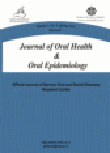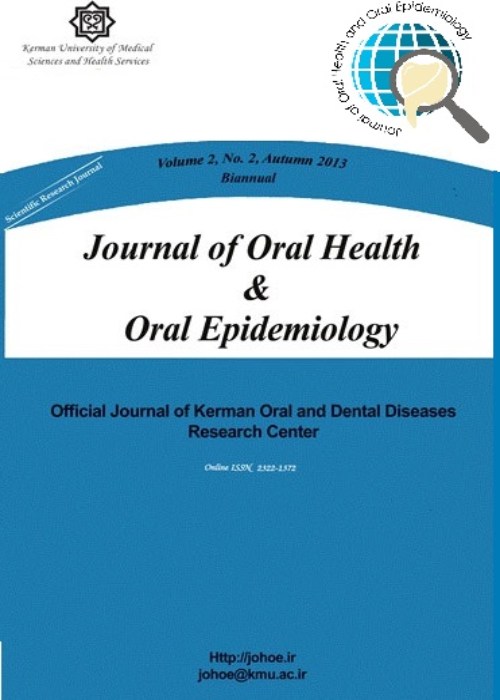فهرست مطالب

Journal of Oral Health and Oral Epidemiology
Volume:3 Issue: 1, Winter-Spring 2014
- تاریخ انتشار: 1393/03/30
- تعداد عناوین: 8
-
-
Page 1Background And AimWater fluoridation is one of the methods for prevention of dental caries. The purpose of this study was to review water fluoridation in the world and in Iran, and its effectiveness in reported literature.MethodsThis paper is not a systematic review, but reviews the literature. “Water fluoridation” was used as a keyword for searching (electronic and hand search) in specialist databases. Many studies show that fluoride ion is lower than its optimal level in almost of all of Iran’s provinces.ResultsDental caries is prevalent among Iranian children and adults. Water fluoridation has chosen as a method for prevention and control dental caries in most of the countries. This method can be of a great for help to the Iran health policies to find a solution in Iran.ConclusionThe cities in Iran need a careful and scientific program for water fluoridation according to their climate.Keywords: Dental Caries, Fluoride, Iran, Water Fluoridation
-
Page 2Background And AimMalocclusions are major traits whose prevalence should be noticed, by gender, among high school students to program oral health status in a society and clarify the needs and demands of this orthodontic field.MethodsIn a cross-sectional population-based study, using a stratified random cluster sampling design, a sample of 1338 students of Shiraz, aged 14-18 years from 15 high schools, located in four different regions of Shiraz was obtained and evaluated clinically for malocclusion traits. Using tongue blades, researchers studied the students under normal room illumination conditions.ResultsThe overall prevalence of malocclusion was 23.70%. Angle’s classes I, II, and III malocclusion were observed in 12.78%, 9.94%, and 0.97% of the samples, respectively. There was no statistically significant difference in the overall prevalence of malocclusion between sexes. Other malocclusion traits evaluated were edge-to-edge occlusion (4.78%), crossbite (1.93%), and open bite (1.19%).ConclusionThe results of this study showed a high prevalence of malocclusion class I as well as an edge to edge malocclusion trait. Considering the findings, health care officials are expected to pay more attention to oral health fields.Keywords: Malocclusion, Adolescents, Oral Health Status, Shiraz, Iran
-
Incidental dentomaxillofacial findings on cone beam computed tomography images of Iranian populationPage 3Background And AimThe present study aimed to assess the nature and prevalence of incidental findings in cone beam computed tomography (CBCT) images of oral and maxillofacial patients.MethodsIn this cross-sectional study, 773 CBCT samples were retrieved from archives of a private oral and maxillofacial radiology center. Any findings that were not related to the reason of CBCT request was recorded in forms designed originally for this study.Results475 patients out of 773 had at least one incidental finding. It composed about 60% of the patients. The largest frequency of incidental findings were cases of periapical lesions. (n = 189), followed by mucous thickening of maxillary sinus (n = 170), retained root (n = 32), impaction and 3rd molar (n = 26). Other incidental findings were torus (n = 25), dental anomalies (n = 13), vertical root fracture (n = 5), intra bony lesion and periapical pathosis (n = 4) and the lowest frequency was sialoliths (n = 1).ConclusionAbout half of the subjects have had at least one incidental finding, so the precise review of the CBCT images seems to be necessary.Keywords: Incidental Findings, Cone Beam Computed Tomography, Dentomaxillofacial
-
Page 4Background And AimDental caries is a multifactorial disease that affects people of any age, sex, and race. Significant caries index (SiC index) has been defined by World Health Organization (WHO) to evaluate caries status in different societies. The aim of this study was to determine the SiC index in 15-year-old children in Kerman.MethodsThis descriptive cross-sectional study was carried out on 300 of 15-year-old children that had been selected by systematic clustering sampling in Kerman. Data were collected by questionnaire (parents’ educational level, parents’ occupation, birth rank, number of children in family, tooth brushing, fluoride use, and regular dental visits) and clinical examination. Teeth were examined by dental mirror, according to WHO criteria. Data were analyzed in SPSS by using ANOVA, t-test, and Kruskal-Wallis tests.ResultsThirty-two and nine brushed their teeth twice daily, 49.8% had never used dental floss, 47.8% had regular dental visit, 80.66% did not use fluoride mouthwash, and 34.4% were caries free. The mean of decayed, missing, and filled teeth (DMFT) was 1.83 ± 1.26 and SiC index was 3.80. There was a significant correlation between the SiC index and parents’ job and birth rank of student. There was also significant correlation between regular dental visit and use of fluoride mouthwash and SiC index.ConclusionThe prevalence of dental caries in 15 years student in Kerman is still high. Using DMFT and SiC indices together may help to show oral health status better than DMFT index alone. Further studies are recommended.Keywords: Decayed, Missing, Filled Teeth, Significant Caries Index, Kerman, Oral Hygiene, Dental Caries, 15, Year, old
-
Page 5Background And AimThe objective of the present study was to evaluate the knowledge of a group of Iranian academic dentists regarding incisor hypomineralization (MIH) in two dental schools in Iran.MethodsA survey was undertaken amongst the teaching staff of the dental schools of Shiraz and Tehran Universities of Medical Sciences. The questionnaire consisted of two sections. In the first section respondents were asked to provide socio-demographic information including year and place of receiving, and type of dental qualification. The second section included questions regarding perception and recognition of the MIH defect in their clinical practice, the incidence and severity of the defect (represented by its clinical presentation), their knowledge of its prevalence, possible determinant factors, and their clinical experience with the management strategies for MIH. Data were analyzed using frequency distribution and Pearson''s chi-square test for categorical data. The critical level for alpha was set at 0.05.ResultsA response rate of 61.3% was achieved. The vast majority of the respondents (85.7%) had encountered MIH in their professional work, with 48.8% indicating that yellow-brown opacities were the most prevalent lesion type. A significant difference between specialists was reported in relation to the frequency of observation of MIH (χ2(5) = 15.3; P < 0.001). Resin composite was the most popular material used in treating teeth with MIH (62%). Endodontists (90.0%) and pediatric dentists (77.8%) used resin composite significantly more than other specialist groups (χ2(5) = 5.8; P < 0.001). Adhesion was the most commonly reported influence on material choice (62.0%).ConclusionMIH is a defect encountered by Iranian dental academic staff with a considerable disparity in knowledge and views regarding its clinical pattern.Keywords: Molar Incisor Hypomineralization, Iranian Dental Academics, Knowledge
-
Page 7Background And AimVarious measurement devices are available for detection of halitosis. For epidemiologic studies, it is necessary to use a portable and small device. This study aimed to investigation of correlation between measuring the device (Etiquette checker) with Halimeter.MethodsOne hundred volunteers (students and patients) participated in this study. The amount of volatile sulfur compounds was carried out by Halimeter and compared with Etiquette measurement. The sensitivity and specificity of Etiquette checker was detected comparing with Halimeter.ResultsThe sensitivity and specificity test with Etiquette checker were 86% and 100%, respectively. The best sensitive and specific point of this device was no. 2 for mouth odor detection.ConclusionEtiquette checker had acceptable sensitivity and specificity for detection of oral malodor. In the future epidemiologic studies, this device could be used.Keywords: Halitosis, Halimeter, Instrumental Measurement, Sensitivity, Specificity
-
Page 8Background And AimUntil now there are a few case reports in which idiopathic gingival enlargement and aggressive periodontitis are diagnosed in combination but in none of them unilateral aggressive periodontitis was seen.CASE REPORT: A 25-year-old female was referred with the chief complaint of swelling of the gingiva in the regions of right upper and lower jaws, for the past 7 years. No relevant medical or family history was recorded. There was not any local or environmental factor. On physical examination, generalized diffused enlargement of gingiva was observed. Radiographs showed unilateral advanced destruction of supporting bone in right upper and lower sextants. The histological analysis of excisional biopsy revealed hyper parakeratinized epithelium. Enormous distribution of inflammatory cells was seen in subepithelial tissue.ResultsThe combination of gingival fibromatosis (GF) and unilateral aggressive periodontitis in this rare case can be a kind of syndromic form that is uncommon in GF. There is little information in this area.Keywords: Gingival Fibromatosis, Agressive Periodontitis, Unilateral Bone Loss, Gingival Enlargement


